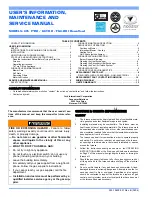
Page 22
31-5000729 Rev. 0
8.
After assembly, wipe excess cement from pipe at end
of fitting socket. A properly made joint will show a bead
around its entire perimeter. Any gaps may indicate an
improper assembly due to insufficient solvent.
9.
Handle joints carefully until completely set.
Venting Practices
Figure 19. Piping Suspension Guidelines
* See table 10 for allowable pipe.
NOTE
- Isolate piping at the point where it exits the outside wall or
roof in order to prevent transmission of vibration to the structure.
SCHEDULE 40
PVC - 5'
all other pipe* - 3'
Wall
e
d
i
s
t
u
o
e
d
i
s
n
i
24” maximum
3/4” minimum
Wall Thickness Guidelines
insulation
(if required)
•
In areas where piping penetrates joists or interior walls,
hole must be large enough to allow clearance on all
sides of pipe through center of hole using a hanger.
•
When furnace is installed in a residence where unit is
shut down for an extended period of time, such as a
vacation home, make provisions for draining condensate
collection trap and lines.
Figure 20.
CHIMNEY
OR GAS
VENT
(Check sizing
for water
heater only)
FURNACE
(Replaced
by EL195)
WATER
HEATER
OPENINGS
(To Adjacent
Room)
If the furnace replaces a furnace which
was commonly vented with another gas appliance,
appliance must be checked. Without the heat of the
original furnace flue products, the existing vent pipe
is probably oversized for the single water heater or
other appliance. The vent should be checked for
proper draw with the remaining appliance.
REPLACING FURNACE THAT
WAS PART OF A COMMON
VENT SYSTEM
the size of the existing vent pip for that gas
Exhaust Piping (Figure 22)
Route piping to outside of structure. Continue with installation
following instructions given in piping termination section.
Do not discharge exhaust into an existing stack or
stack that also serves another gas appliance. If vertical
discharge through an existing unused stack is required,
insert PVC pipe inside the stack until the end is even
with the top or outlet end of the metal stack.
CAUTION
The exhaust vent pipe operates under positive pressure
and must be completely sealed to prevent leakage of
combustion products into the living space.
CAUTION













































